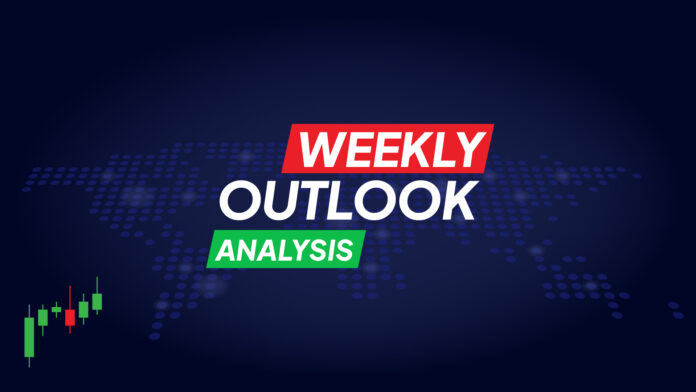Key points to watch out for:
- Fed focuses on Wednesday as U.S. inflation remains at elevated levels
- Will Friday’s jobs report bring respite or further market angst?
- Eurozone GDP and CPI figures in focus for the euro
- Chinese PMIs and New Zealand employment also on tap
Could the Fed jeopardize rate cut expectations?
This week will be busy for the US dollar, with the Federal Open Market Committee (FOMC) meeting and the April employment report among other data releases likely to keep market traders on their toes.
The main focus during the first half of this week will be the Federal Reserve’s policy decision on Wednesday, May 1. Until recently, the May meeting was anticipated to establish the groundwork for a June rate cut. However, following better-than-expected employment and inflation data, expectations have shifted, with a rate cut now unlikely before September at the earliest.
Lacking recent FOMC forecasts to guide the May decision, market traders will hang on every word from Fed Chairman Jerome Powell during his press conference, seeking clues about the timing of policy easing. Those still hoping for a summer rate cut will likely be disappointed.
Recent remarks from Fed officials suggest that the committee is comfortable pausing a while longer, though most still expect some easing by year’s end. Powell may again reiterate the need for patience, even as he continues to hint at the possibility of cutting rates.
However, investors will be eager to gauge Powell’s confidence in significant inflation reductions over the coming months, which could justify easing the current tightening policy. If Powell is a bit more hawkish than usual, the dollar may resume its upward trend.
Labor market showing no signs of cooling
In the absence of new signals from the Fed, investors will focus on the Non-Farm Payrolls report on Friday, May 3.Far from slowing, the U.S. economy added a staggering 303,000 jobs in the month of March. Analysts are forecasting a figure of around 210,000 in April, while the unemployment rate is expected to remain at 3.8%.
The vital factor is whether wage increases will remain moderate and continue to grow at a rate above 4.0%. Any acceleration in average hourly earnings could generate a full-scale panic about fading rate cut bets and any upside surprise in the headline payrolls data.
This week, investors will also monitor the April ISM manufacturing and non-manufacturing PMIs, scheduled for Wednesday, May 1, and Friday, May 3, respectively. If the ISM services PMI also underperforms, similar to the S&P Global services PMI, it could counter the impact of robust employment data and positive signals from the Fed.
In terms of other releases, Tuesday, April 30 will bring quarterly labor costs, the Chicago PMI along with the consumer confidence index. More labor market related indicators will be released on Wednesday, May 1.
Eurozone focuses on GDP and CPI updates ahead of the June cut
Unless wage figures unexpectedly exceed the ECB’s forecasts at the end of May, a June rate cut is considered almost certain. However, the future trajectory of rates beyond that remains uncertain. Year-end market rates have dropped below 75 basis points, indicating around three rate cuts, though Joachim Nagel, head of Germany’s Bundesbank, cautioned that a June cut doesn’t guarantee subsequent reductions.
Preliminary data on first-quarter GDP and April CPI, set for release on Tuesday, April 30, will likely shape forecasts for the rest of the year, though the outlook for June will probably not change without significant deviations from these estimates.
The economy in Europe grew by about 0.2% quarter-over-quarter during the first three months of the year, after flat growth during the fourth quarter. An improvement in the economic outlook would reduce the urgency for the European Central Bank to cut rates aggressively, so policymakers will need to see further declines in inflation in order to maintain the moderate stance. Headline inflation is expected to remain flat in March at 2.4%.
Chinese PMI indices and New Zealand employment figures are slated for release
China is enjoying a pickup in economic activity. In March, the official composite PMI achieved its highest level not recorded since May last year, although much of this rise is thanks to the services sector and the recovery in the manufacturing sector remains tepid.
The latest official and Caixin/S&P Global PMIs will be released on Tuesday, April 30.
If the economy gains momentum in April, it will bode well for risk-sensitive assets like oil and equities, along with commodity-linked currencies such as the Australian and New Zealand dollars.
Meanwhile, investors in the New Zealand dollar will closely watch the domestic employment figures set for release on Wednesday, May 1. First quarter data on employment growth, the unemployment rate and wages will perhaps throw up clues as to the likelihood of the RBNZ cutting rates soon, as the central bank recently gave its strongest indication yet that the next move will be downward.
The kiwi would come under pressure if the labor market shows a slowdown.
Elsewhere, Canada will release monthly GDP estimates on Tuesday, April 30 and Japan will release preliminary March industrial production figures on the same Tuesday. Switzerland will release April CPI figures on Thursday, May 2, and on Friday, May 3, the Norwegian central bank will announce its interest rate decision.



